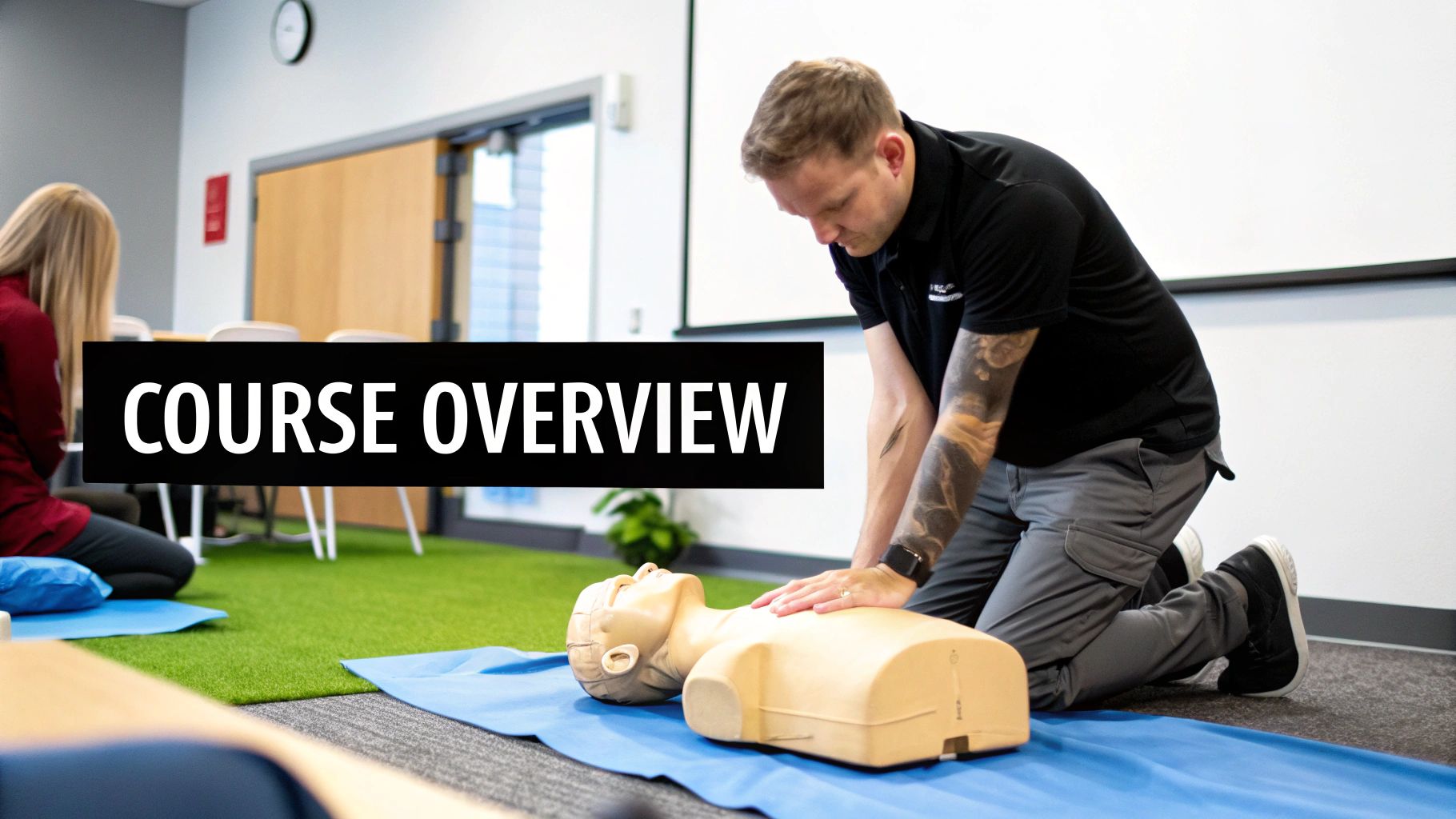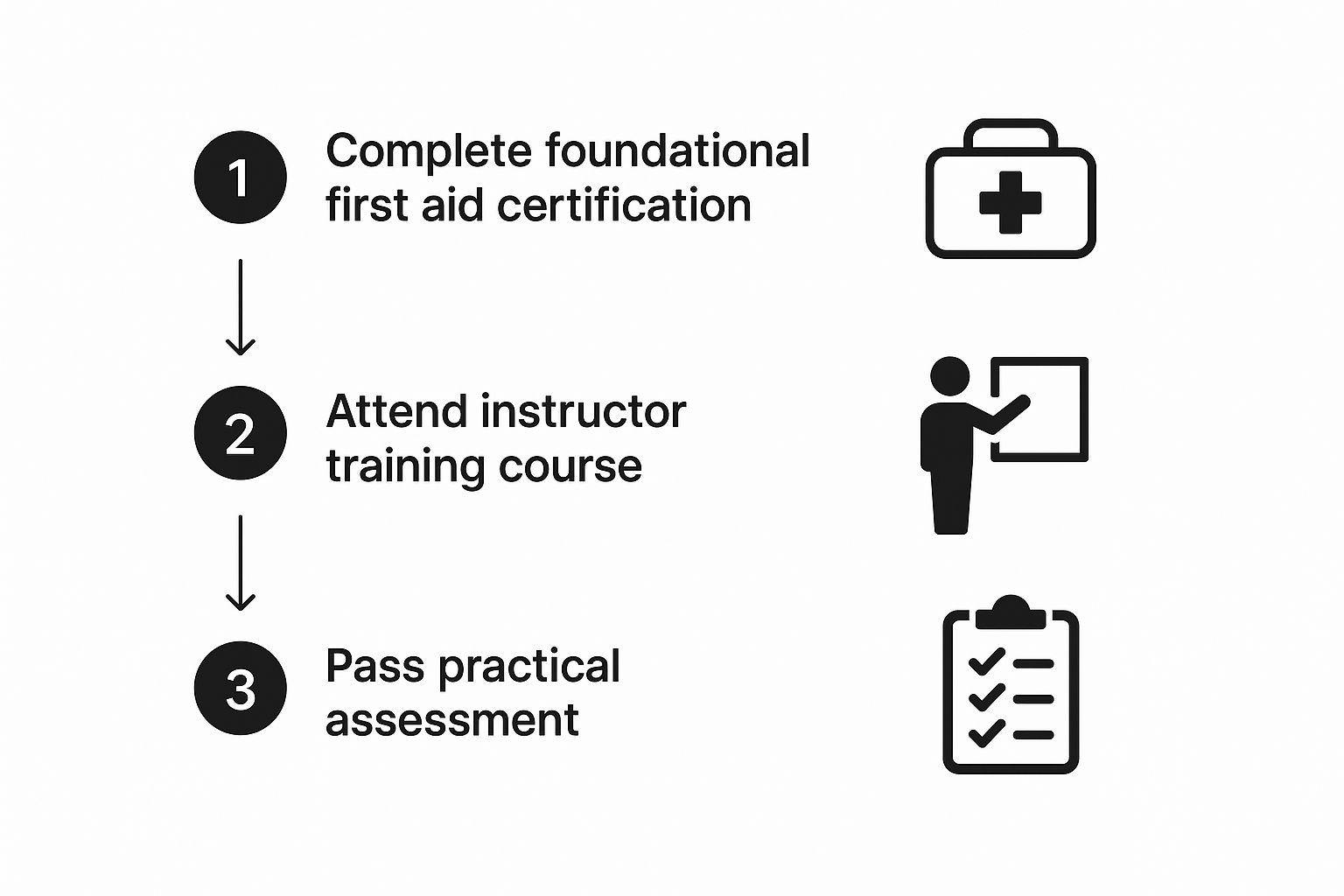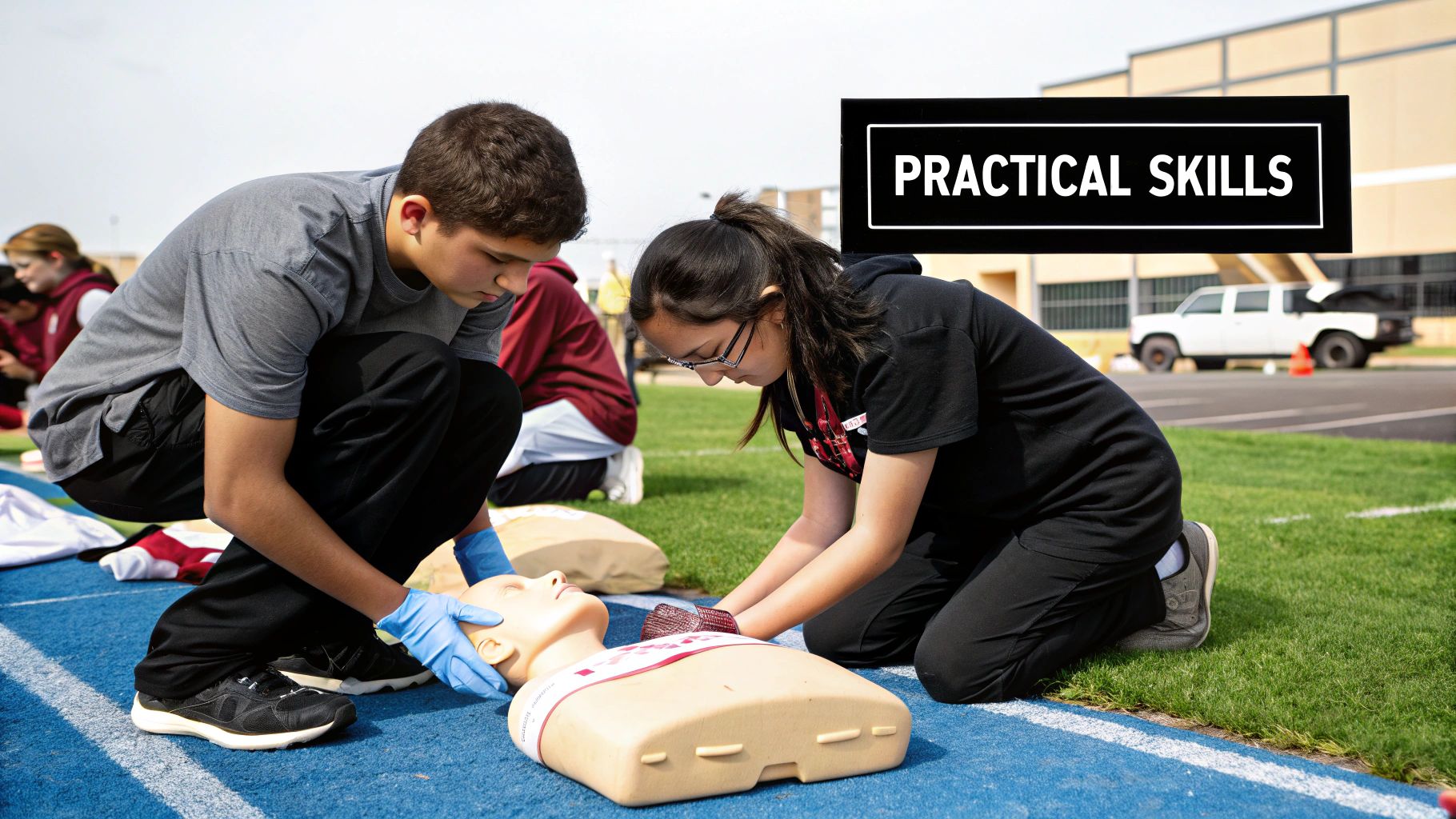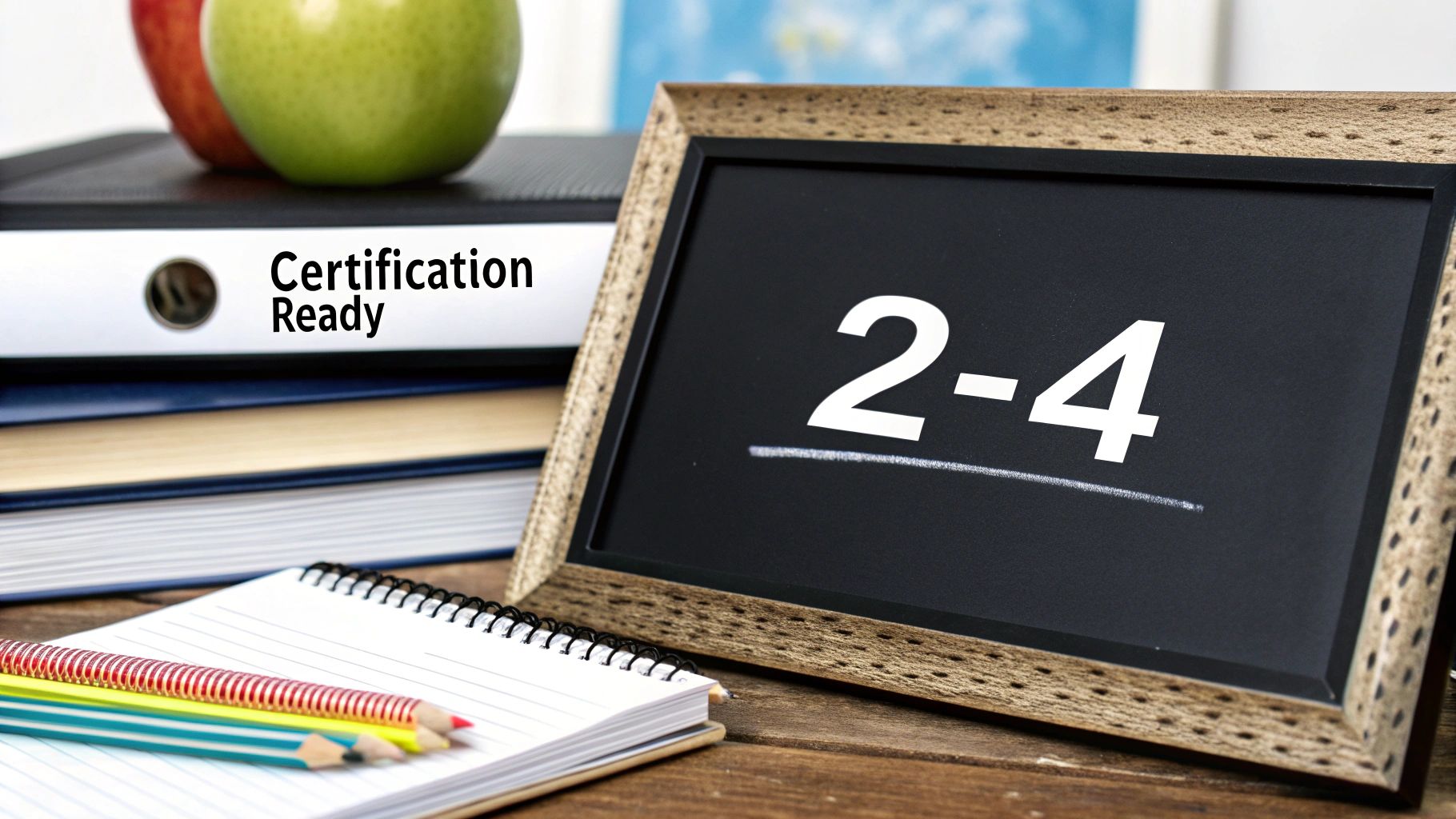A first aid instructor course is your gateway to teaching others how to save lives. It’s an advanced program that transforms someone skilled in first aid into a confident, effective educator—someone who can certify others in critical emergency response skills.
If you have a genuine passion for helping people and are looking to make a real, tangible impact, this could be the perfect path for you.
Is Becoming a First Aid Instructor Right for You?

Ever thought about turning your first aid knowledge into a career or even a meaningful side hustle? It's a role that goes way beyond just knowing what to do in an emergency. It’s about empowering entire communities with confidence and life-saving skills.
Becoming a first aid instructor is a deeply fulfilling job. You become a crucial link in the chain of survival, equipping everyday people—from new parents to office workers—to act decisively when it matters most. This isn't just a job; it's a commitment to public safety.
Assessing Your Motivation and Impact
Before you dive in, it’s worth taking a moment to ask yourself why you want to teach. The best instructors I've seen are driven by a genuine desire to help others. They're patient, communicate clearly, and can break down complex medical topics into simple, actionable steps.
Think about the kind of impact you want to have. Do you enjoy leading groups, public speaking, and giving constructive feedback? Are you the person friends and family turn to for calm, practical advice in stressful situations? If that sounds like you, then you already have the core qualities of a great instructor.
To help you think it through, here are some of the key traits that make for a successful first aid instructor.
Key Attributes of a Successful First Aid Instructor
AttributeWhy It Matters in Teaching First AidPatienceStudents learn at different paces. You need to be able to explain concepts multiple times without frustration.Clear CommunicationIn an emergency, simplicity is key. You must be able to deliver instructions that are easy to remember under pressure.EmpathyUnderstanding a student's fear or hesitation is crucial for building their confidence.Passion for HelpingYour enthusiasm is contagious. A genuine desire to empower others makes the learning experience more impactful.Calm DemeanorYou are the model for how to behave in a crisis. Your calm presence helps students feel more capable.
These attributes aren't just "nice-to-haves"—they're the foundation of effective teaching that can truly prepare someone to save a life.
On top of the personal fulfillment, this career is also seeing some major growth. The global demand for first aid training is booming, thanks to stronger workplace safety rules and a bigger public focus on emergency preparedness. The market was valued at USD 4.81 billion in 2023 and is on track to hit around USD 7.69 billion by 2032.
This growth translates directly into opportunity. As an instructor, you could work for an established training provider, a large corporation, or even forge your own path. For those with an entrepreneurial spirit, you might be interested in our guide on how to start a CPR training company, which offers a roadmap for building your own business from the ground up.
Navigating the Prerequisites for Instructor Training
Before you can dream of standing in front of a class teaching others how to save a life, you have to prove you’ve mastered those skills yourself. I always tell aspiring instructors to think of it like this: a pilot needs to log serious flight hours before they can train the next generation. Your own first aid knowledge is the absolute bedrock of your teaching career.
That’s why every credible first aid instructor course starts with a clear set of prerequisites. They’re not there to be a barrier; they’re there to ensure you’re truly ready for the responsibility. The most basic requirement is holding a current, valid certification in the very subjects you want to teach—almost always Adult and Pediatric First Aid, CPR, and AED. It's not just about having the card; it's about having the confidence and skill to back it up.
Foundational Certifications and Age Requirements
Most of the big training organizations, like the American Red Cross and the American Heart Association, set a minimum age for their instructor candidates. This is usually 16 or 18 years old, ensuring a certain level of maturity for the role. After that, it's all about your existing credentials.
Your provider-level certifications are your ticket in. They prove you have the essential knowledge to build on. The instructor course isn't about re-learning CPR; it's about learning how to teach CPR, how to evaluate skills, and how to manage a classroom. If you're just starting out, you can get a good overview of what's involved by reading about getting your CPR and AED certification.
This is the standard path nearly everyone follows from student to certified instructor.

As you can see, getting that foundational certification is the first, non-negotiable step. There are no shortcuts here.
Why Proficiency Is Non-Negotiable
Holding a certificate is one thing. Being truly proficient is another entirely.
As an instructor, you’re not just going through the motions. You’re the one who has to spot a student’s subtle mistake, answer tough "what if" questions, and adapt techniques for people of all different sizes and abilities. Your students will be looking to you as the expert in the room, and you need to own that role.
This is where real-world experience becomes so incredibly valuable. While it's not always a formal requirement, having actually managed an emergency—or even just consistently practicing your skills—builds a kind of confidence and "muscle memory" that you can't get from a textbook.
Think about it. A student asks, "What if the person is way too big for me to do chest compressions the way you showed me?" An instructor who is merely certified might freeze. A proficient instructor, however, can immediately offer practical advice on body positioning and leverage, building that student’s confidence so they leave the class not just certified, but truly prepared to act.
Inside The First Aid Instructor Course Curriculum

So, you're wondering what really goes on inside a first aid instructor course. Let me start by telling you what it’s not about. It’s not about re-learning how to wrap a bandage or do chest compressions. You've already proven you know the material inside and out.
This course is all about making a crucial shift in your mindset. You're moving from being a skilled doer to becoming an effective teacher of those life-saving skills. It’s a completely different ballgame.
The curriculum gives you an entirely new toolkit. Forget spending hours on the “what” of first aid; you’ll be diving deep into the “how” of teaching it. It’s a hands-on, interactive experience designed to get you ready for the real-world challenges of leading a classroom.
Mastering The Art of Teaching
A huge chunk of the course is dedicated to adult learning principles. Why? Because teaching a room full of corporate professionals is worlds apart from teaching new parents or a group of high school students. The goal isn't just to get them a certificate—it's to make the knowledge stick so they can act confidently under pressure.
You'll explore different teaching styles and, more importantly, learn how to adapt your delivery to keep any audience hooked. This involves:
- Leading Group Discussions: Learning how to field those tough "what if" questions that aren't in the manual and getting everyone involved.
- Managing Classroom Dynamics: You'll practice handling everything from a disruptive student to accommodating different learning speeds, all while keeping the environment positive and judgment-free.
- Using Scenarios That Work: This is about designing realistic emergency simulations that build real, practical confidence, not just textbook knowledge.
This is where you truly learn the art of instruction. You'll get hands-on practice breaking down complex skills—like the steps for using an AED—into simple, memorable chunks that people can actually recall when it matters most.
From Skills Practice To Skills Evaluation
Another core piece of the training is learning how to properly evaluate your future students. Honestly, this is a massive responsibility. You’ll be taught to watch skills being performed with a critical eye, giving feedback that's both constructive and encouraging.
The objective isn't to find fault but to build competence. An instructor must know the difference between a minor deviation in technique and a critical error that would render the skill ineffective in a real emergency.
This training ensures you can confidently and objectively decide if a student meets the standards for certification. You’ll also get up to speed on the administrative side of things—how to properly document class completions, manage rosters, and keep your own instructor credentials current. If you want a closer look at what a well-structured class entails, our guide on CPR training curriculum guidelines offers some great context.
This level of detailed training is essential because instructors are on the front lines of public health. As of 2021, the global rate of CPR training was only around 40%, with huge differences between countries. Skilled, effective instructors are the key to closing that gap and building more resilient communities. By becoming one, you’re directly helping to raise that number.
The Certification Process: What to Expect
Finishing the coursework for a first aid instructor course feels like a huge accomplishment, and it is. But the journey isn't quite over yet. The final phase is the evaluation process, where you put everything you've learned into practice and prove you're ready to lead a class on your own.
This final step is what turns your training into a recognized, official credential. It’s less about what you know and more about how well you can teach it to others. Think of it as your teaching "driver's test."
The Written Examination
First up, you'll likely have a written exam. Most certification bodies, like the American Red Cross or American Heart Association, require you to pass one. This test typically focuses on the material from the instructor course itself, not just the basic first aid skills you already mastered.
Expect questions centered on:
- Teaching methodologies and adult learning principles.
- Course administration and the proper record-keeping you'll need to do.
- Skills evaluation criteria and how to fairly and accurately assess your future students.
- The specific policies and procedures of the certifying organization you're working with.
This exam is really about confirming you've got a solid grasp of the responsibilities that come with the instructor title. It makes sure you're prepared to run your classes by the book.
Your Monitored Teaching Session
Now for the most critical part of the evaluation: the practical skills demonstration. This is where you'll be asked to teach a segment of a first aid or CPR course to your peers while a supervising Instructor Trainer observes you. It’s your chance to shine and show off your newfound teaching chops.
You'll be evaluated on several key performance points. Can you clearly explain a skill? Demonstrate it accurately? Manage the classroom and provide effective, encouraging feedback to your "students"? Your trainer is looking for confidence, clarity, and competence.
Don’t just recite the manual. This is your opportunity to inject your personality into the material. The best instructors connect with their students, tell relevant stories, and create an engaging learning environment. Your goal is to show you can do more than just present information—you can inspire confidence.
For many, this is the most nerve-wracking part of the process. My advice? Just breathe. Trust your training and focus on connecting with your students. Preparation is key, so practice your assigned topic out loud beforehand until it feels natural.
For those looking to teach for specific organizations, understanding their unique instructor pathways is a big help. You can get more details on a popular route by reading our guide on becoming a Red Cross instructor. Successfully navigating this monitored session is the final hurdle to earning your certification and beginning your career empowering others with life-saving knowledge.
So You're a First Aid Instructor. Now What?

You did it. You pushed through the coursework, aced the exams, and that official instructor certificate is finally in your hands. But after the initial celebration, a big question pops up: now what?
Holding that certificate is like getting the keys to a whole new set of doors. Behind each one is a unique, rewarding path where you can make a real difference. This is more than just a job hunt; it's about building a career, or even a meaningful side hustle, using skills that are always in demand. You've got the flexibility to decide how and where you want to teach.
Finding Your Footing in the Training World
One of the most straightforward ways to get started is by partnering with an established training provider. This is a fantastic way to get your feet wet. You'll get a steady stream of classes without having to worry about the marketing or logistics. You simply show up and do what you do best: teach.
Another popular route is working with community organizations—think youth groups, churches, or local non-profits. These gigs are often incredibly fulfilling because you’re directly empowering people in your own community. This approach is also a powerful way to build a local reputation that leads to word-of-mouth referrals.
And of course, there's the entrepreneurial path: starting your own first aid training business. This gives you the most freedom but also means you'll need to wear a few more hats, like marketing, sales, and admin. The trade-off? You set your own schedule, your prices, and build a brand that truly reflects your personal teaching philosophy.
Building Your Reputation and Landing Gigs
No matter which road you take, your reputation is your most valuable asset. Those first few classes are crucial. Use them to gather testimonials and prove you're an effective educator. Don't be shy about asking for feedback—it’s the best way to refine your teaching style.
Think about the specific needs in your area. The demand for workplace training, for example, can be huge. A 2017 survey in Norway found that an incredible 90% of people had received first aid training, and for 52% of them, it happened at work. This points to a massive opportunity for instructors who can cater to corporate clients.
Your specialization can become your superpower. Don't be afraid to find a niche that sets you apart. Are you passionate about teaching new parents? Or maybe your background makes you the perfect person to train construction crews or dental office staff.
Look beyond the usual settings. Niche markets can be a goldmine. For instance, you could specialize in unique topics like applying first aid in grooming mishaps. The more you can tailor your courses to a specific audience, the more in-demand you'll become.
At Ready Response, we constantly see instructors find success by becoming the go-to expert for a particular industry or community. They turn their passion into a thriving, life-saving career.
Frequently Asked Questions About Instructor Courses
Diving into a new career path always brings up a few questions. When you're thinking about becoming a first aid instructor, you’re probably wondering about the practical side of things—like the investment in time and money, and what your future could look like.
Let's clear the air and tackle the most common questions head-on. This way, you'll have the full picture before you commit to this incredibly rewarding journey.
How Much Does an Instructor Course Typically Cost?
The cost for a first aid instructor course can vary, but you should generally plan to invest somewhere between $400 and $800. This range really depends on the certifying organization—think American Red Cross or American Heart Association—and the specific training provider you go with.
Think of it as the first real investment in your new professional path. The fee almost always covers:
- Instructor Manuals and Materials: All the essential books and digital resources you'll need to get started.
- In-Person Training: The hands-on classroom time you'll spend with an experienced Instructor Trainer.
- Your Initial Certification: The actual credential you earn once you successfully pass the course.
Some providers might bundle in extras like training manikins or AED trainers, which can nudge the price up a bit. Always double-check what's included in the fee so you're comparing apples to apples.
What Is the Time Commitment Involved?
Most first aid instructor courses are designed to be intensive and efficient. The in-person or blended learning part—where you're actively working with a trainer—usually takes about one to two full days.
But that's not the whole story. There's often an online pre-course component you’ll need to finish on your own time. This self-paced work covers foundational knowledge and teaching principles, setting you up to hit the ground running during the hands-on sessions. All in all, be prepared to dedicate a solid weekend or a couple of weekdays to get it done.
The real time commitment extends far beyond the initial course. Great instructors are always practicing their skills, prepping for classes, and staying on top of the latest guidelines. The course is just the starting line.
How Often Is Recertification Required?
Your instructor certification isn't a one-and-done deal. To make sure you're always teaching the most current and effective techniques, you'll need to recertify every two years.
The good news is that the recertification process is usually much shorter and cheaper than your initial course. It’s designed to refresh your teaching skills and get you up to speed on any changes to first aid protocols or educational standards. Staying current is a core responsibility for any credible instructor. For more detailed answers to common questions like this, you can always check our main Ready Response FAQs page.
What Is the Income Potential for a First Aid Instructor?
Your income as a first aid instructor is incredibly flexible and really depends on how you want to work. If you join an established training company, you might earn a set rate per class, which often ranges from $150 to $300 or more.
On the other hand, if you decide to go into business for yourself, your earning potential is tied directly to your own drive. You could charge $50-$100+ per student and teach classes for groups of 10 or more. A single corporate training gig could easily net you over $1,000. It's a field where your passion and business smarts can absolutely create a very healthy income.
At Ready Response, we provide a clear pathway for aspiring educators through our instructor development programs. We equip you with the skills, support, and credentials needed to transform your passion for helping others into a fulfilling and successful career. Learn more about our instructor courses at readyresponsepa.com.
